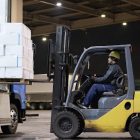Choosing the right forklift can be a daunting task. Especially when you’re looking for used forklifts for sale.
The market is flooded with options. From different types of forklifts to various forklift providers and dealers, the choices are endless.
But don’t worry. This guide is here to help.
We’ll walk you through the process of selecting the best used forklifts. We’ll cover everything from understanding your specific needs to evaluating the reputation of a forklift dealer.
By the end of this guide, you’ll be equipped with the knowledge to make an informed purchase. Let’s get started.
Understanding Your Forklift Needs
Before diving into the market, assess your requirements. This is crucial to finding the right machine for your operation.
Consider the tasks your forklift must perform. Will it lift heavy loads or handle small items?
Understand your working environment. A warehouse setting might need a different forklift than a construction site.
Here’s a quick checklist to help outline your needs:
- Weight and type of materials to move
- Height for lifting loads
- Type of terrain or surface conditions
- Frequency and duration of use
- Space constraints and maneuverability requirements
By having a clear understanding of these factors, you can narrow down your choices efficiently. This will guide you toward the most suitable used forklifts.
Types of Forklifts and Their Applications
Selecting the right type of forklift is essential. Different models serve various functions based on their design and capacity.
Counterbalance forklifts are the most common. They are versatile and can handle many indoor tasks efficiently.
Reach trucks excel in narrow aisles. They’re ideal for warehouses where space is limited.
Pallet jacks are great for lighter loads. They’re often used to move pallets over short distances.
Each type has unique uses:
- Counterbalance Forklifts: General indoor and outdoor use
- Reach Trucks: Narrow aisle applications
- Pallet Jacks: Short distance transport
- Telehandlers: Construction and agriculture
- Order Pickers: High-level stock picking
Knowing the applications and limitations of each type helps in making an informed decision. This understanding ensures that you choose the best match for your operational needs.
The Benefits of Buying Used Forklifts
Purchasing used forklifts offers significant cost savings. New forklifts can be expensive, while used options are more budget-friendly.
Immediate availability is another advantage. Unlike new forklifts, used models are ready for quick delivery and use.
You can get familiar brands at lower prices. This allows access to quality forklifts without stretching your budget.
Additionally, depreciation is slower for used forklifts. This means better resale value if you decide to sell in the future.
Key Factors to Consider When Choosing a Used Forklift
Before buying a used forklift, assess your specific needs. Consider the types of tasks it must perform.
Lift capacity is crucial. Make sure the forklift can handle the loads you expect to lift regularly.
Think about lift height. The forklift should be able to reach your required heights safely and efficiently.
Fuel type also matters. Choose between electric, gas, or diesel options based on your operational requirements and costs.
Inspect the forklift’s maintenance history. A well-maintained machine is likely more reliable and has a longer lifespan.
Consider the forklift’s age and hours of operation. These factors affect both performance and potential maintenance needs.
Check for safety features and compliance with OSHA regulations. Ensuring safety standards is vital for workplace safety.
Keep transportation and potential repair costs in mind. These add to the total cost of ownership.
Key factors include:
- Lift capacity
- Lift height
- Fuel type
- Maintenance history
- Safety compliance
Being thorough in your evaluation helps make a smart purchase.
Inspecting a Used Forklift: What to Look For
A thorough inspection is necessary before buying a used forklift. Check for signs of wear and damage.
Inspect the mast operation. Ensure it lifts and lowers smoothly without hitches or noises.
Examine the tires for wear. Worn tires can lead to poor performance and require replacement.
Watch for fluid leaks. Leaks may indicate maintenance issues or impending repairs.
Review the forklift’s structural integrity. Ensure there are no cracks or significant rust.
Key inspection points include:
- Mast operation
- Tire condition
- Fluid leaks
- Structural integrity
A careful inspection helps ensure reliability and safety. Pay attention to detail to avoid future hassles.
The Importance of Test Drives and Maintenance History
A test drive can reveal much about a forklift’s condition. It lets you personally assess its performance.
During the test drive, pay attention to the controls. Ensure they are responsive and intuitive.
Ask for the forklift’s maintenance history. This record can reveal how well it was cared for.
Regular maintenance is a sign of a dependable machine. Detailed records indicate thorough previous ownership.
Evaluating Forklift Providers and Dealers
Choosing the right forklift provider or dealer is crucial. A reputable dealer offers quality and support.
Research the dealer’s reputation. Look for customer reviews and testimonials on various platforms.
Consider the range of forklifts they offer. A wide selection often means better chances to find the right fit.
Check if the dealer provides after-sales support. Ongoing service and support ensure continued forklift efficiency.
Additional Costs and Warranty Considerations
When purchasing a used forklift, additional costs may arise. It’s important to budget for these potential expenses.
Transportation fees can add up quickly, especially if the forklift needs to be shipped over long distances.
Consider potential repair costs. Some used forklifts might require immediate maintenance or parts replacement.
Check if the forklift has a remaining warranty. A warranty provides peace of mind and can cover unexpected repairs.
Safety and Compliance: Ensuring Your Forklift is Up to Standard
Safety is paramount when choosing a used forklift. Always ensure the forklift meets OSHA regulations.
Check for essential safety features like seat belts and warning lights. These features help in preventing accidents.
It’s crucial to verify the forklift’s stability. This includes assessing its balance under load conditions.
Regular safety inspections are necessary. Ensuring the forklift’s compliance with industry standards protects both operators and investments.
Negotiating the Best Deal and Understanding Market Value
Understanding the market value of used forklifts is essential before negotiating. Research recent sales data for similar models.
Use this information as leverage during price discussions. An informed buyer often gets better deals.
Negotiation involves more than just price. Consider asking about additional benefits like free delivery or extended warranties.
Evaluate multiple offers from different forklift providers. Comparing options ensures you get the best possible deal.
Remember, a successful negotiation results in mutual satisfaction. Both buyer and forklift dealer should feel positive about the transaction.
Conclusion: Making an Informed Decision
Choosing the best used forklift requires careful evaluation. Pay attention to your specific needs and market trends.
Thorough research and inspection lead to a smart investment. Partner with a reliable forklift provider for a successful purchase.





